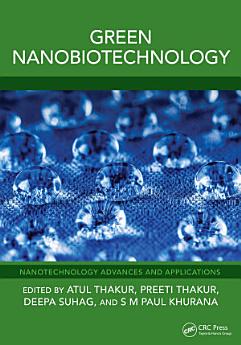Green Nanobiotechnology
Acerca de este libro electrónico
Acerca del autor
Dr. Atul Thakur is the Director of the Institute at Amity Centre for Nanotechnology, Amity University, Haryana, India. He earned his M.Phil. and Ph.D. degrees from Himachal Pradesh University, Shimla. With a prolific academic career, Dr. Thakur has authored over 190 research papers published in international, peer-reviewed, SCI, and Scopus-indexed journals. Following his Ph.D., Dr. Thakur secured a post-doctorate research position at the Electronics Department of the University of Brest, France, focusing on the size reduction of patch antennas. Subsequently, he was appointed as a post-doctorate at the prestigious Taiwan National University, where his research delved into high-density memory storage systems and devices. His extensive research portfolio encompasses various domains, including ferrites for microwave applications, high-frequency applications, RADAR-absorbing materials, water purification, antenna miniaturization, high-density memory storage systems, sensor applications, metamaterials, biomedical applications, and agricultural applications. Dr. Atul Thakur holds the credit for filing 50 patents to date. In addition to his research accomplishments, Dr. Thakur has delivered numerous invited talks at national and international conferences worldwide. He has successfully completed several government-funded projects sponsored by ANR, DRDO, MNRE, DAE, among others. Recently, Dr. Thakur achieved recognition by securing prestigious international grants from the Royal Academy of Engineering, UK. Currently, he serves as the Head of the Amity Centre for Nanotechnology and Amity School of Applied Sciences at Amity University, Haryana. Notably, Dr. Thakur has also taken the initiative to establish a startup, NanolatticeX.
Dr. Deepa Suhag serves as an assistant professor at the Amity Centre for Nanotechnology, Amity University, Haryana, India. She earned her Ph.D. from Amity University, Uttar Pradesh, Noida, in 2017. With an impressive academic background, she has authored 25 research articles published in prominent international journals and has successfully filed 6 patents, one of which has been granted under her name. Her expertise lies in the broad spectrum of biomaterial engineering, with a specific focus on wound healing and tissue regeneration. Dr. Suhag's contributions in these areas underscore her commitment to advancing knowledge and making impactful strides in the field of nanotechnology.
Prof. Preeti Thakur currently holds the position of Head, Department of Physics, at Amity School of Applied Sciences, Amity University, Haryana. A recipient of a post-doctorate from Taiwan and a gold medalist in Masters, she successfully completed her Ph.D. in Physics from Himachal Pradesh University, Shimla. With a remarkable career spanning over 20 years, she has amassed extensive teaching and research experience. Her research endeavors encompass the synthesis and characterization of magnetic nanoparticles for various applications, including radar-absorbing materials, sensors, high-frequency technologies, wastewater treatment, and biomedical and agricultural applications. Prof. Thakur boasts an impressive publication record, with over 160 articles featured in SCI/Scopus-indexed international journals. Additionally, she has filed 47 patents and actively contributes as a reviewer for international-indexed journals.
Prof. (Dr.) S. M. Paul Khurana, PhD, is a retired professor of biotechnology and head of the University Science Instrument Centre, Amity University, Haryana, Gurgaon. Earlier, he served as the vice chancellor of Rani Durgavati University, Jabalpur, from 2004 to 2009, project coordinator at AICRP (Potato) from 1994 to 2004, and director of the Central Potato Research Institute, Shimla, from 2002 to 2004. He is the founder director of Amity Institute of Biotechnology, Gurgaon, Haryana; Dean, Science, Engineering, and Technology; and consultant at CIP/FAO in 1992, 1996, and 1997. He has more than fifty-four years of experience in pathology, virology, and nanotechnology. He has published more than 230 research papers, 135 reviews and chapters, and authored and/or edited 25 books.




